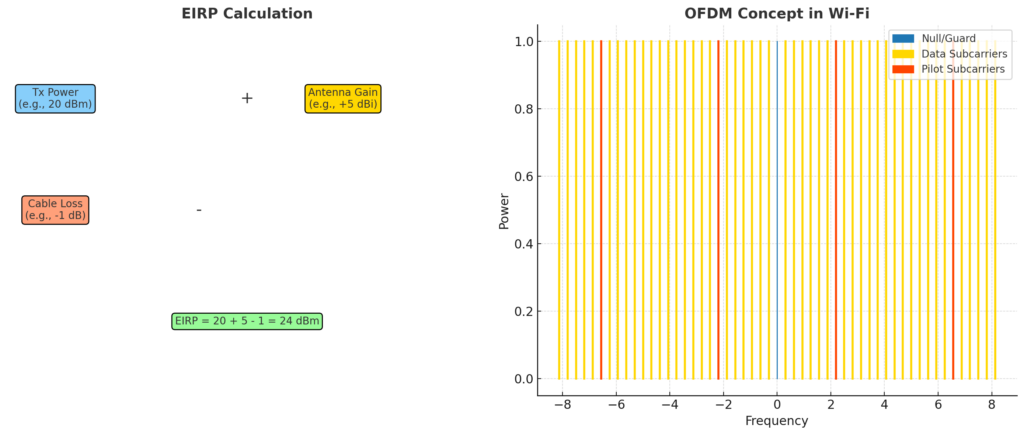1. EIRP (Equivalent/Effective Isotropic Radiated Power)
Definition
EIRP is the total RF power radiated from an antenna in the direction of its strongest emission, assuming the antenna radiates equally in all directions (isotropic).
It’s a calculated value that combines:
- Transmitter Power Output (P_tx)
- Antenna Gain (in dBi — gain relative to an isotropic antenna)
- Losses (cable, connectors, etc.)
Formula (in dBm): EIRP=Ptx(dBm)+Gant(dBi)−Lcable(dB)\text{EIRP} = P_{\text{tx}} (\text{dBm}) + G_{\text{ant}} (\text{dBi}) – L_{\text{cable}} (\text{dB})EIRP=Ptx(dBm)+Gant(dBi)−Lcable(dB)
Why EIRP Matters
- Regulatory compliance — FCC, ETSI, and other bodies limit EIRP in certain bands to avoid interference.
- Coverage & performance — Higher EIRP increases range, but also increases the chance of interference to others.
- Wi-Fi design — Different bands have different EIRP limits (e.g., 2.4 GHz in the U.S. = 36 dBm, some DFS channels have lower limits).
Example
If:
- Radio output = 20 dBm (100 mW)
- Antenna gain = 5 dBi
- Cable loss = 1 dB
EIRP=20+5−1=24 dBmEIRP = 20 + 5 – 1 = 24\ \text{dBm}EIRP=20+5−1=24 dBm
24 dBm ≈ 0.25 W effective radiated power.
2. OFDM (Orthogonal Frequency Division Multiplexing)
Definition
OFDM is a digital modulation scheme where a channel is split into many smaller subcarriers, each carrying part of the data.
The “orthogonal” part means subcarriers are mathematically spaced so they don’t interfere with each other, even if they overlap in frequency.
How It Works
- Channel Division: A Wi-Fi channel (e.g., 20 MHz wide) is split into subcarriers (~312.5 kHz each for 802.11a/g/n).
- Parallel Data Streams: Each subcarrier is modulated individually (BPSK, QPSK, QAM).
- IFFT/FFT Processing: Transmitter uses an Inverse Fast Fourier Transform to combine signals; receiver uses FFT to separate them.
- Guard Intervals: Tiny gaps or cyclic prefixes prevent inter-symbol interference.
Advantages
- Resistant to multipath fading (common indoors where reflections occur).
- Efficient spectrum use (subcarriers overlap without interfering).
- Scalable — works for 20/40/80/160 MHz channels.
OFDM in Wi-Fi
- Introduced in 802.11a (5 GHz, 1999)
- Used in 802.11g (2.4 GHz, 2003)
- Still forms the basis of 802.11n/ac/ax — although OFDMA (Orthogonal Frequency Division Multiple Access) in Wi-Fi 6/7 adds multi-user capability.
OFDM Example in 20 MHz Wi-Fi Channel
- Total Subcarriers: 64
- 48 data subcarriers
- 4 pilot subcarriers (for synchronization)
- 12 null/guard subcarriers
- Symbol duration: ~4 μs (with guard interval)
3. How EIRP and OFDM Relate
- EIRP = how strong your signal is radiated into the air.
- OFDM = how that signal is structured and modulated for efficient transmission.
- In Wi-Fi, EIRP limits determine how far an OFDM-modulated signal can travel without violating regulations.
